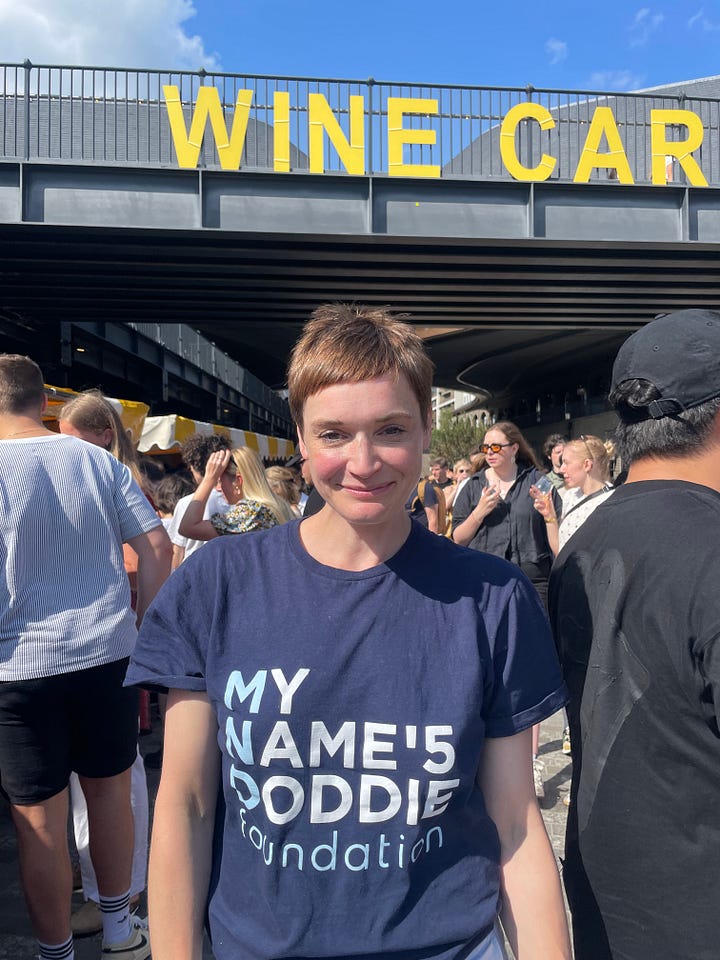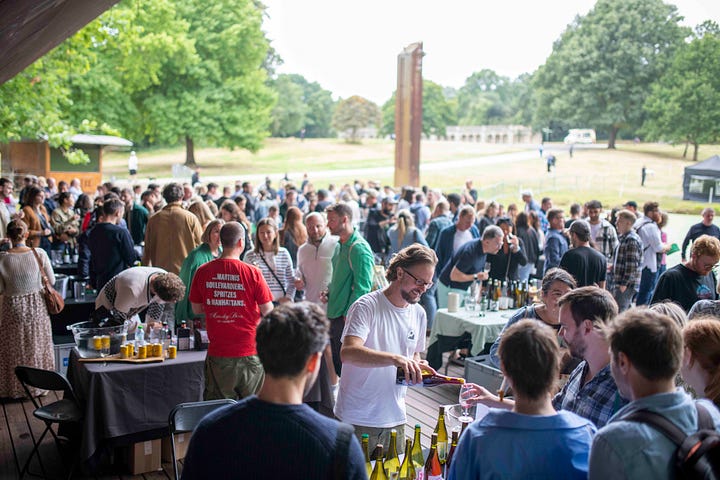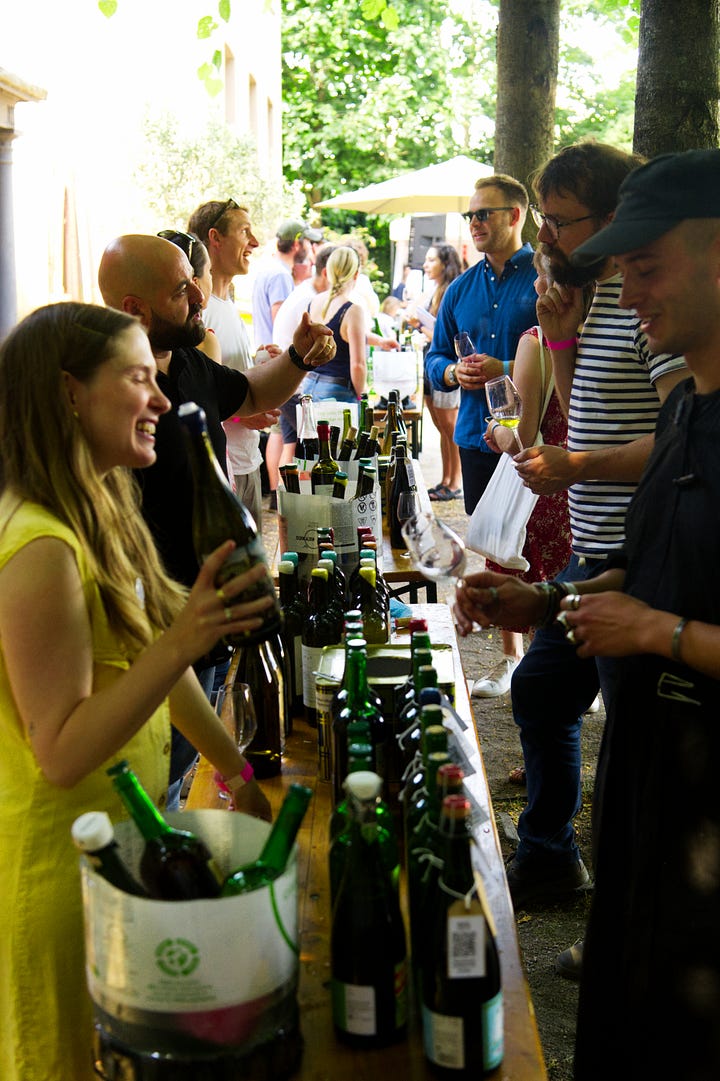Wine’s festival vibe
London's summer wine fairs are drawing in a new breed of wine drinker. I went to Wine Car Boot fair to investigate. Plus: what I've been drinking this week




The central plaza of King’s Cross’s Coal Drops Yard is thronged with hundreds of people in blazing June sunshine – all tasting and drinking wine. Despite the wine industry’s current obsession with young people not drinking its products, you wouldn’t find any evidence for that in this predominantly twenty- and thirty-something crowd, here for the thirteenth edition of the Wine Car Boot fair. It’s just one of the wine festivals now sweeping London. And the way that they have ridden the coattails of a broader festival culture offers ample proof that wine isn’t as fusty as some people still seem to believe.
Outdoor festivals, mostly dedicated to music, have become a major feature of the British summer. Yet the scale of their emergence over the past 30 years is a little-remarked development. When I finished university in 1987, there was of course Glastonbury, then around half its current size: I trudged through the mud that year to watch the glorious last UK gig of US hardcore legends Hüsker Dü. August Bank Holiday weekend meant Reading Rock, as it was then: no 16-year-old kids celebrating GCSEs, as today, and a lot more old rockers, as suggested by 1987 headliners The Mission, Status Quo and Alice Cooper. There was the Monsters of Rock heavy metal day in August at Donnington Park, grungier still and really not cool (1987 headliner: Bon Jovi). And that was about it, save for a few folk festivals such as Cropredy and Cambridge.
But it’s not just music that has embraced festival culture. Take for example the (mostly) outdoor phenomenon of farmers’ markets, unknown as such in the UK before the 1990s. And festival culture across the board has been made more inviting by the rise, over the past 15 years, of street-food culture. Forget the dodgy burgers of 1980s Glasto: now just in my local South London Sunday farmers’ market you can get Ethiopian stews, alpine tartiflette, Vietnamese banh mi, gourmet sausages and Guyanan roti – never mind British charcuterie and cheese, biltong and olives.
“The whole festival and street-food vibe is different now – it’s a much bigger scene, more aspirational,” says Ruth Spivey, founder and organiser of Wine Car Boot. She came up with the idea after running a wine bar at a street food market: “you could hang out, listen to music, eat burgers and drink nice wine – and before then, you couldn’t do those things at same time.” Nevertheless, when Spivey organised the first fair in 2013, it was a bit of a leap in the dark.
“I was working in the wine trade, including shifts in independent wine shops,” she tells me. “I had accidentally got experience of events. And there wasn’t really a consumer wine event in London at the time. Three Wine Men was going [started in 2011 by Oz Clarke, Tim Atkin MW and Olly Smith] but there was nothing that focussed on independent shops.”
She also points out that at some of the big consumer events, there is so much wine that it’s confusing (even I sometimes feel that at bigger fairs.) And she says that even though a newer generation of independent, cooler wine shops were coming through then, “No matter how useful and cool the shops were, trying not to be intimidating, people still seemed intimidated. So we aimed to get people out of the shop and into a car park to taste.”
Spivey’s goal was to change shopping habits, so that after the fair, “people use small shops instead of going back to Tesco.” The success of that mission is difficult to gauge, she says, but many independents come back to the fair year after year. She also reports, “people say that until they came to Wine Car Boot, they didn’t know about their local wine shops.” Her format is simple: the fair is free but you buy tokens to pay for glasses of wine. This year it hosted 19 wine stalls plus vermouth and cider – and drew up to 1,700 people.
Such events have been helped by the rise of a new generation of wine bars and independent stores over the past 15 years or so. In London, bars including Terroirs (2008-21), The 10 Cases (founded 2011) and Sager + Wilde (founded 2013 after a year as a pop-up) brought a more relaxed style to the genre. Indeed the South London Wine Fair, taking place at the Crystal Palace Bowl on July 19 this year, is run by the Crystal Palace Wine Club bar.
The bar and South London fair are the project of Tom Grater, a former journalist who decided after the Covid pandemic that he wanted a change – and to follow his passion for wine. He studied for the Wine and Spirit Education Trust Level 3 exam, which entailed opening a fair few bottles to taste at home: when he found that he and his partner couldn’t drink all he’d opened, he started a WhatsApp group to share it. That morphed into him hosting tastings at local café, and when in October 2022 a site came free in a parade of shops around the corner from his house, he started the bar.
“Opening a wine bar in Anerley Hill was a bit mad at the time,” he concedes – but it is still going strong, and has since been joined by a branch up the hill of Peckham’s Sourcing Table. Grater also now runs a small importing business, as well as a sister bar in Brixton, the Vining Street Wine Club.
Now in its third year, the South London Wine fair’s format is different to Wine Car Boot: one ticket covers tasting all you want within a two-hour slot. Time limiting that slot was one lesson Grater says he learnt from the first fair: “when you let people taste as much as they want all afternoon, it’s carnage.” This year Grater is bringing over five winemakers from Spain, one from Slovenia – a speciality area for him, with its high number of clean natural wines – plus at least three English producers. He expects up to 400 people to attend.
Elsewhere in South London, there’s a similar format to Bedrock Wine Fair in Deptford this coming Sunday, 6 July. Now in its fourth year, Bedrock is run by London importers and natural/artisanal specialists Wines under the Bonnet and Otras Spinas, bringing together their products as well ones from several other small importers of low-intervention wines. There will be an impressive 30 winemakers attending this year, one reason why organiser Yvonne Neilson says, “We wanted to keep it quite intimate – if you’re three deep at a table, you can’t hear what’s being said.”
She expects around 400 visitors at the venue, the historic Master Shipwright’s House on the banks of the Thames. There will also be a number of food stalls, including south London cheese specialists Mons. One ticket covers all your drinks.
Perhaps inevitably, some bigger players are now trying to get in on the act too. Later next month at Hackney Bridge, 19-20 July, the Rioja region is holding a fair to celebrate its 100 years as a recognised Denominación de Origen. There will be street food stalls and cooking demonstrations by celebrated Spanish chefs José Pizarro and Omar Allibhoy – as well, of course, as a range of 50 Riojas to taste (you can redeem the cost of the ticket against tasting samples: you buy a ticket and then tasting tokens.)
“You can expect a great vibe with DJ’s, food pairing, wine masterclasses from me,” says BBC TV Saturday Kitchen’s wine expert Olly Smith. “I’ll also be teaming up with chefs José and Omar on stage for some recipe fun with matching Rioja and food. Come on down!”
But whatever the exact format, London’s wine fairs look like they are here to stay – and that they are doing what they set out to in attracting a younger generation of drinkers. “I know nothing about wine,” Dominic Rodrigues, age 26, admitted to me cheerfully at Wine Car Boot last month. “But I’ve absolutely enjoyed it – it’s a really nice event.” His friend Carolina Delfelice, also 26, added, “Very often there’s a bit of a barrier [with wine]. But it’s been fun and informal.” And sipping wine in the sunshine on a summer’s day amid chatter and laughter, who can disagree with them?
What I’ve been drinking this week
Samartzis “Dio Potamia” Kontoura, Barrique 2022, Thiva – from an unusual white Greek grape from modern Thebes, just north of Athens, this is fresh, fruity and balance, with a judicious touch of oak - lovely (Tanners, £16.70.)
Banzao Mencía de San Pedro de Olleros 2022, Bierzo – Bierzo is the Denominación in Galicia, north-west Spain, that is best known for the Mencía red grape; this is one of the nicest examples of it I’ve tasted in a while. Fragrant, almost heady nose; bright, crystalline red fruit and the grape’s briskly acidity. One of the few reds I feel like drinking in this week’s heat, this is refreshing and light at just 12.5 per cent alcohol (ca £15, currently N/A UK: the Wine Society recently sold a batch of this and another Banzao cuvée on early release, so perhaps they will be offering it sometime on their main list.)
Black Book Winery “Trouble Every Day” Pinot Noir 2022 – I wrote fairly recently about Battersea’s urban winery, Black Book: this is a good example of the quality they’re managing. Surprisingly dark and structured – it sees time in Burgundian barrels – this brims with bramble and cherry fruit, crunchy and well balanced. Not cheap, but then this kind of boutique wine – only around 1,400 bottles produced – never is (from the winery in person or mail order, £30. The Sourcing Table also currently have it by the glass - £12.50 - or bottle.)
Transparency declaration: I visited and tasted at Wine Car Boot fair as a guest of the organisers. Olly Smith is a friend.
Look out for my new book with Jane Masters MW, Rooted in Change: The Stories Behind Sustainable Wine - out 1 October from the Academie du Vin Library.




